Abstract
The changes in land cover patterns in the Mongolian Plateau can reveal the regional status of sustainable development. Based on land cover data from 1990–2020, the study reveals the process of land cover change on the Mongolian plateau and integrates those changes with UN Sustainable Development Goals (SDGs) to further evaluate regional sustainable development status. Result revealed there is a stable rate of land cover change (0.16%) for the Mongolian Plateau, but with diverse shifting trends for various land cover types and SDGs indicators in past 30 years. Croplands (SDG2) showed a growth trend in the last five years, which was different from its initial obviously decreasing trend. The status of water (SDG6) showed a clear decreasing trend, which presents a major threat to this arid-to-semi-arid region. The built area (SDG11) increased continuously, but the long upward trend has slowed in recent years. The forest area (SDG15) declined, but it has recently recovered. Grasslands showed diverse changes in various steppe types (including real, meadow, and desert steppe types) while still experiencing land degradation. The expansion of sand areas presents a hidden risk of increasing sandstorms. Comparative analysis revealed that there have clear differences between Mongolia and Inner Mongolia due to the various government policies. In general, the land use degree in Mongolian Plateau increased annually. This indicated that the climate change and human activities have more and more influences, and it is still facing severe challenges for specific SDGs indicators in the region.
1. Introduction
The Mongolian Plateau is located in the inland highlands of northeast Asia. It contains high-altitude terrain and is an arid-to-semi-arid area. In most areas, land surface cover is diverse, with large areas of grassland and forest, water, cropland, and built areas for living or mining. Because of the high latitude and elevation, the plateau has a variable climate which experiences sandstorms in spring, drought or flooding in summer, and cold and freezing in winter, all of which influence human activities. Overgrazing occurs in most areas, including in rich grassland in semi-humid regions and poor grassland in the Gobi region. Generally, the ecological background is fragile and sensitive. Recent economic development has severely disturbed the natural resources of the Mongolian Plateau. Deforestation, continuous exploitation of mineral resources, and degradation of grasslands have caused serious imbalances in the Mongolian Plateau ecosystem [1,2]. By 2016, approximately 72% of Mongolia’s land experienced desertification [3]. Several dust storms in Mongolia in the spring of 2021 not only resulted in human and livestock casualties but had a direct impact on the ecology of surrounding countries in Northeast Asia. In 2019, the UN General Assembly announced that 2021–2030 would be the decade of the UN Ecosystem Recovery Plan. This plan supports the restoration of 350 million hectares of degraded ecosystems (a land surface area almost comparable to the size of India) by 2030. Without doubt, the Mongolian Plateau is a key target area for ecosystem recovery.
In 2015, the UN Sustainable Development Summit was conducted in its New York headquarters, and 193 member states of the United Nations officially adopted the 17 Sustainable Development Goals (SDGs). The SDGs aim to solve social, economic, and environmental development problems comprehensively between 2015 and 2030. The remarkable feature of the Mongolian plateau is the vast and sparsely populated land. Therefore, the changes in land cover can indicate the status of sustainable development of the region. Specifically, SDG2, SDG6, SDG11, SDG13, and SDG15 and their related targets are the most applicable for the sustainable development of the Mongolian Plateau [4,5]. These goals include the following: the elimination of hunger, achievement of food security, improvement of nutritional status, and promotion of sustainable agriculture (SDG2); to provide and manage water and environmental sanitation for all people sustainably (SDG6); to build inclusive, safe, disaster-resistant, and sustainable urban and human settlements (SDG11); to address climate change and its impacts urgently (SDG13); to protect, restore, and promote the sustainable use of terrestrial ecosystems; to sustainably manage forests; to combat desertification; to stop and reverse land degradation; and to mitigate loss of biodiversity (SDG15). Utilising these sustainable development indicators for the Mongolian Plateau is an urgent scientific endeavour.
Previous studies of land use and land cover change in the Mongolian Plateau over long periods have informed this study. Wei [6] used MODIS data in combination with relevant statistical data to study land use changes in Mongolia and analysed their driving forces. Wang [7] extracted Inner Mongolia Autonomous Region land use data for 1990, 1995, 2000, 2005, 2010, 2015, and 2018. Tuya [8] used the Wuzhumuqin-Wendur Khan transect of the Mongolian plateau as a case study, used Landsat TM data from 1988 to 2016 as the data source, analysed the utilisation characteristics for transect grassland as a function of year and nation, indicated the principal grassland interference factors, and explored effective mitigation strategies. Research by Li [9], based on global land coverage remote sensing data and field investigation, studied the land use patterns and the driving factors in the China–Mongolia–Russia Economic Corridor from 1992 to 2019, following the collapse of the former Soviet Union and the privatisation of Mongolia. Based on remote sensing images and object-oriented classification methods, Cheng [10] obtained the land coverage data set of Ulaanbaatar city, Mongolia, characterised Ulaanbaatar urban expansion, and analysed its driving forces. Gao [11] revised the permafrost distribution from 2003 to 2019 and utilised the 1 km MODIS surface temperature products to analyse the spatial and temporal change characteristics and their influence on the Mongolian Plateau. Yao [12] used different machine learning methods to extract water information from the Selenga River basin in Mongolia based on the Google Earth Engine (GEE) platform. Zhang [13] studied spatial and temporal changes (1997, 2007, 2017) in cultivated land in Mongolia. Shi [14] compared and analysed the conversion of land use types between Mongolia and Inner Mongolia from 1970 to 2005 using time series research.
These studies have advanced our understanding of land use changes for Mongolia and Inner Mongolia at different spatial and temporal scales as well as during specific periods. However, few studies provided a complete and comprehensive picture of land use and land cover changes refer to the 2030 SDGs in the Mongolian Plateau over the past 30 years. Thus, a gap exists to analyse the existing land use and land cover data to support management and research efforts to achieve the SDGs in the Mongolian Plateau. The aim of this study is to elucidate the general sustainable development status of the Mongolian Plateau using land cover data for the years 1990, 2000, 2010, 2015 and 2020, and to compare differences in its two different geographical units in Mongolia and Inner Mongolia, China. The driving forces of land use and land cover change in the Mongolian Plateau were also studied and discussed with the goal of providing a reference for the implementation of SDGs in the Mongolian Plateau.
2. Materials and Methods
2.1. Study Area
The Mongolian Plateau is located in an arid-to-semi-arid region in Northeast Asia, between 37–53° N and 88–120° E with an area of 274.95 km2. Its main body includes Mongolia and Inner Mongolia (China) (Figure 1). The Mongolian Plateau has a temperate continental climate with prevailing north-westerly winds [15]. The average annual rainfall is approximately 200 mm. Summer seasons are usually very hot, while winter seasons are long and cold. Sudden weather changes, frequent freezing, and intense snow and sandstorms often occur during winter. From north to south, the surface vegetation includes forest, grassland (including meadow, real, and desert steppe types), and Gobi sand cover. The regional ecology is diverse and fragile.
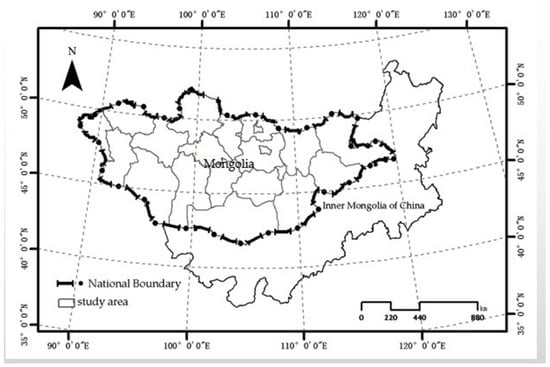
Figure 1.
The Mongolian Plateau is located in an arid-to-semi-arid region in Northeast Asia, between 37–53° N and 88–120° E.
2.2. Data Sources
The Mongolian land cover data used in this study originated from the Institute of Geographical Sciences and Natural Resources Research, Chinese Academy of Sciences. Inner Mongolia land cover data originated from the Resource and Environmental Science and Data Centre of the Chinese Academy of Sciences. The annual time series data included 1990, 2000, 2010, 2015 and 2020, and had a spatial resolution of 30 m. The classification accuracies for these datasets were 84.19%, 82.12%, 81.84%, 80.76%, and 81.84%, and the Kappa coefficients were 0.8052, 0.7656, 0.7985, 0.7942, 0.7991, respectively [16]. After data integration, the unified classification system included forest, grassland (including meadow, real, and desert steppe), cropland, built, barren, water, and sand areas.
2.3. Model and Methods
The flowchart of this study is shown in Figure 2.
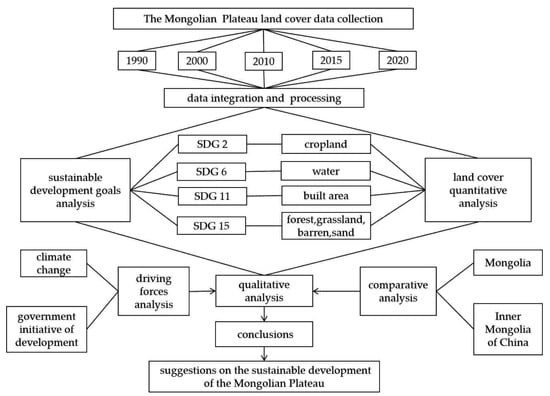
Figure 2.
Study flow chart.
2.3.1. Analysis of the Distribution Pattern
The categories and areas of land change during the selected study period were statistically analysed according to the corresponding table of land use. ArcGIS software was used to create land use maps and analyse their spatial layout.
2.3.2. Analysis of Rate of Change
This study utilised a dynamic perspective on land use to describe the rate of land use change quantitatively. The change in area of a certain land use type during a unit of time is divided into a single and a comprehensive land use dynamic perspective [17,18,19]. The intensity of a specific land use type over time is called a single land use degree, and is calculated according to the following formula:
where H is the single land use dynamic attitude in this area, T is the time interval between the beginning and end of the study, Ua is the area at the beginning of the study, and Ub is the area at the end of the study. The comprehensive land use degree, which can reflect the rate of change in the overall regional land use change, is calculated as follows:
where W indicates a regional comprehensive land use dynamic perspective, LUi−j indicates the area converted from category j to non-category i land use type during the study time interval, LUi indicates the area of land use type i in the initial study, and T indicates the time interval between the beginning and the end of the study.
2.3.3. Analysis of Change Direction
A land use transfer matrix was selected to describe and analyse the transition between land use types [20,21,22]. This can characterise the direction of transfer between land use changes in different categories. The land use map of different periods was superimposed using ArcGIS 10.7 software. Statistical analysis of the superimposed land use transfer matrix was conducted in Microsoft Excel, and the area of mutual transformation between land types was obtained through analysis.
The land use transfer matrix is expressed as follows:
where S represents the area, and n represents the total number of land use types.
2.3.4. Analysis of the Land Utilization Degree
The most used method to study changes in land use is the comprehensive land use index [23]. This index reflects the significance of land use during a specific period and the changes in land use within the research area. Based on research by relevant scholars, a comprehensive index model was selected to calculate the comprehensive land use degree index within the region. The calculation formula is as follows:
where Q is a comprehensive index of the significance of land use. Ai is the land use grade index at the ith grade, and Ci is the percentage of land use area at level i. The grading index for the degree of land use is presented in Table 1.

Table 1.
Table of land use ratings for different land use types.
2.3.5. Comparative Analysis of Mongolia and Inner Mongolia
This study chose the relative rate of change in land use to analyse the regional differences in land use quantity [24]. It reflects the difference in land use situation in Mongolia and Inner Mongolia.
where and represents the area at the beginning and end of the study period of a specific land use type in Area A; and represents the area at the beginning and end of the study period of a specific land use type in Area B.
Suppose is not equal to , meaning that the land type area of area B changes during the study period. If the relative change rate of land use is greater than 1, the change of this land type in region A is greater than that of in region B.
3. Results
3.1. Pattern and Change of Land Use

Table 2.
Land cover area changes in the Mongolian Plateau.
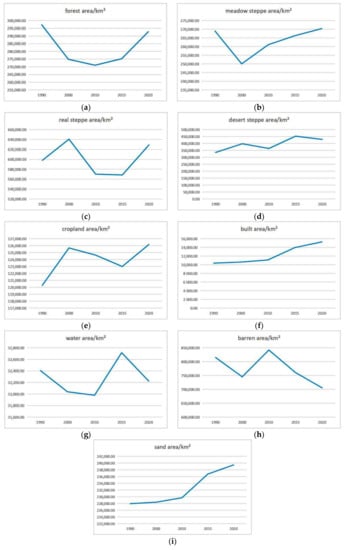
Figure 3.
Trend of land cover area change in Mongolian Plateau: (a) forest area; (b) meadow steppe area; (c) real steppe area; (d) desert steppe area; (e) cropland area; (f) built area; (g) water area; (h) barren area; (i) sand area.
3.1.1. Forest Area
Forests are primarily distributed in the western Greater Hinggan Mountains and within the semi-humid climate zone of the Hangzhou-ai-Kent Mountains (Figure 4). The total forest area decreased between 1990 and 2010 and increased between 2010 and 2020 (Figure 3a). The greatest decrease occurred from 1990 to 1995 and was 0.75%. The maximum increase occurred from 2015 to 2020 and was 1.28%. Compared to 1990, the forest area decreased by 4483.62 km2 by 2020. The average rate of change over 30 years was −0.05%.
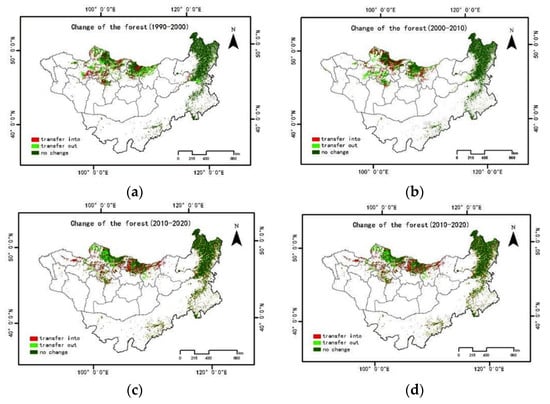
Figure 4.
The forest transfer diagrams: (a) 1990–2000; (b) 2000–2010; (c) 2010–2020; (d) 1990–2020.
3.1.2. Grassland Area
The Mongolian Plateau grasslands are primarily distributed across the Hangzhou-ai, Kent, and Hulun Buir plateaus (Figure 5, Figure 6 and Figure 7). The total meadow steppe area showed a decreasing trend between 1990 and 2000 and an increasing trend between 2000 and 2020 (Figure 3b). The rate of decrease from 1990 to 1995 was 0.70% and the greatest increase occurred from 2000 to 2010 and was 0.44%. A 1377.17 km2 increase occurred from 1990 to 2020. The average rate of change over the past 30 years has been 0.02%. The total real steppe area increased from 1990 to 1995 and decreased between 2000 and 2020 (Figure 3c). The greatest reduction rate was 1.10% from 2000 to 2010, and the reduction rate was 2.13% from 2015 to 2020 (2.13%). Compared to 1990, the real grassland area increased by 31,122.44 km2 by 2020. The average rate of change over the past 30 years has been 0.17%. The total desert steppe area fluctuated between 1990 and 2020 (Figure 3d). The greatest decrease from 2015 to 2020 was 1.03%. The greatest decrease from 2010 to 2015 was 4.86%. Compared to 1990, the desert steppe area increased by 94,058.11 km2 by 2020. The average rate of change over 30 years was 0.93%.
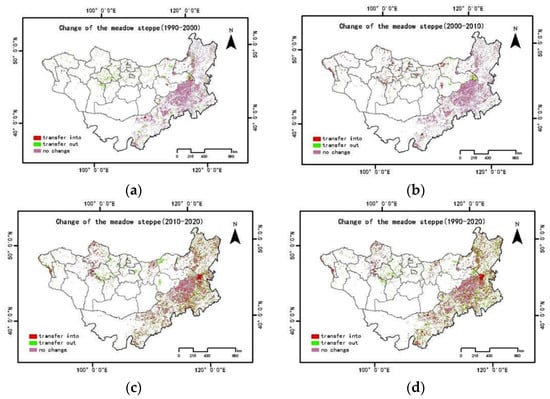
Figure 5.
Meadow steppe transfer diagrams: (a) 1990–2000; (b) 2000–2010; (c) 2010–2020; (d) 1990–2020.
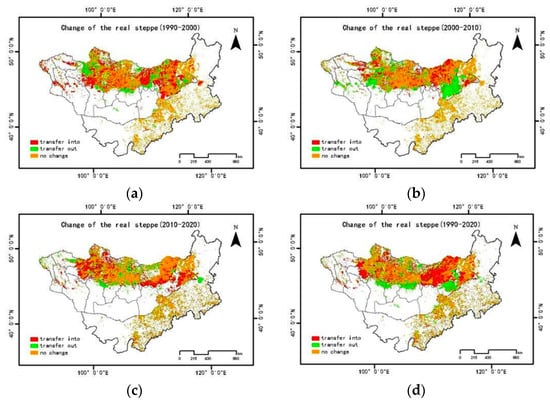
Figure 6.
Real steppe transfer diagrams: (a) 1990–2000; (b) 2000–2010; (c) 2010–2020; (d) 1990–2020.
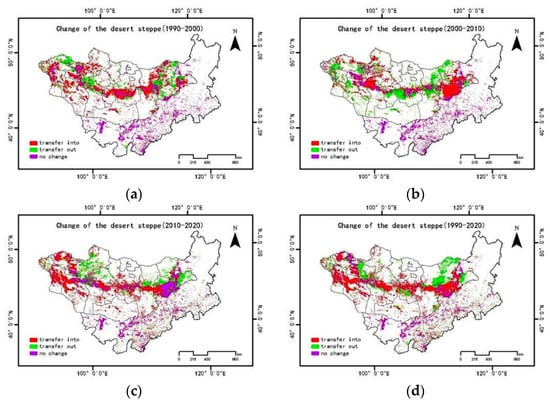
Figure 7.
Desert steppe transfer diagrams: (a) 1990–2000; (b) 2000–2010; (c) 2010–2020; (d) 1990–2020.
3.1.3. Cropland Area
Croplands in Mongolia are mainly distributed in the Selenga River Basin and Valley because of sufficient precipitation and good irrigation conditions. In Inner Mongolia, the croplands are in the central and eastern regions (Figure 8). The total cropland area increased from 1990 to 2000 and from 2015 to 2020. It decreased between 2000 and 2015 (Figure 3e). The largest increase from 2015 to 2020 was 0.52%, and from 2010 to 2015 it was 0.26%. Compared to 1990, the cropland area increased by 5891.68 km2 in 2020. The rate of change over the past 30 years has been 0.16%.

Figure 8.
Cropland transfer diagrams: (a) 1990–2000; (b) 2000–2010; (c) 2010–2020; (d) 1990–2020.
3.1.4. Built Area
The built area on the Mongolia is concentrated in the capital of Ulan Bator. The built area in Inner Mongolia, China is distributed throughout various regions (Figure 9). As shown in Figure 3f, the total built area has increased. The greatest increase observed between 2010 and 2015 was 5.15%. Compared to 1990, the built area had increased by 4901.78 km2 by 2020. The average observed rate of change in the 1930 years was 1.57%.
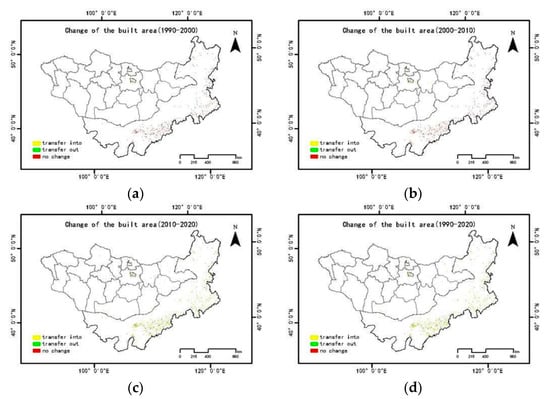
Figure 9.
Built area transfer diagrams: (a) 1990–2000; (b) 2000–2010; (c) 2010–2020; (d) 1990–2020.
3.1.5. Water Area
The Mongolian Plateau is the origin of many rivers, including the Selenga River, Helun, Helal, and Erguna. They are generally located in the northwest region (Figure 10). The total water area increased between 2010 and 2015 and decreased during the other study periods (Figure 3g). The average observed rate of increase from 2010 to 2015 is 0.46%. The highest observed rate of decrease from 2015 to 2020 was 0.30%. The water area decreased by 180.88 km2 between 1990 and 2020. The average observed rate of change over 30 years was −0.02%.

Figure 10.
Water transfer diagrams: (a) 1990–2000; (b) 2000–2010; (c) 2010–2020; (d) 1990–2020.
3.1.6. Barren Area
The barren area of the Mongolian Plateau is widely distributed throughout the Gobi region in central and western Mongolia. This region has severe weather conditions including very little precipitation, an extremely arid climate, and strong winds. In addition, it is a sandy area with sparse vegetation (Figure 11). The barren land area increased between 2000 and 2010 and decreased during other study periods, as shown in Figure 3h. The rate of increase was 1.30% from 2000 to 2010, and the greatest rate of increase occurred from 2010 to 2015, reaching 1.93%. Compared to 1990, barren land decreased by 109,517.53 km2 by 2020. The observed average rate of change over 30 years was −0.45%.
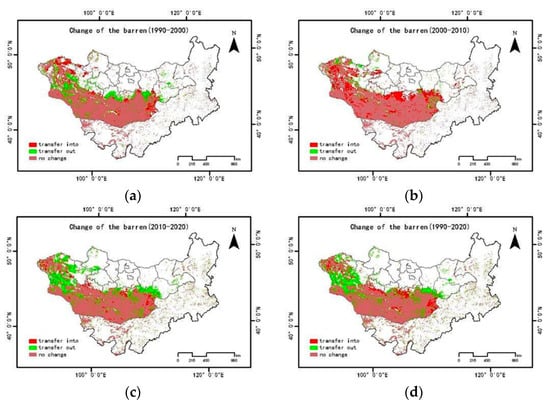
Figure 11.
Barren transfer diagrams: (a) 1990–2000; (b) 2000–2010; (c) 2010–2020; (d) 1990–2020.
3.1.7. Sand Area
The sand areas on the Mongolian Plateau are concentrated in western Inner Mongolia and western Mongolia. These sand areas are distributed among the Badan Jaran, Tengger, and Ulan Bu deserts. Additional sand areas were also located within the Zabu Khan Province and the Gobi region in Mongolia (Figure 12). The total sand area increased between 1990 and 2020 (Figure 3i). The increase rate varied for each decade. The largest increase occurred from 2010 to 2015, when it reached 0.61%. Compared to 1990, the sand area increased by 11,488.36 km2 by 2020. The average observed rate of change over the past 30 years was 0.17%.
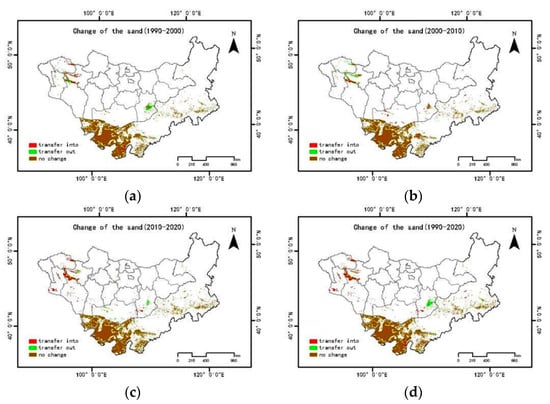
Figure 12.
Sand transfer diagrams: (a) 1990–2000; (b) 2000–2010; (c) 2010–2020; (d) 1990–2020.
3.2. Analysis of Land Use Degree
3.2.1. Land Use Dynamic Degree
Comprehensive land use in the Mongolian Plateau changed the most dramatically from 2010 to 2015, when the land use index changed by 0.71%. In 2015 and 2020, it changed by 0.62%. The average observed change over 30 years from 1990 to 2020 was only 0.16%, which indicates a relatively stable status overall.
3.2.2. Comparative Analysis of Mongolia and Inner Mongolia
Calculated according to Formula (5) (in Section 2.3.5), relative change rates in Mongolia and Inner Mongolia from 1990–2020 is shown in Table 3. Most of the change rate number are less than 1. This indicates that Mongolia and Inner Mongolia have similar physical geographical conditions. Only a small number of the indicators are greater than 1, indicating the higher level of land use activities. These land cover types involve built land, water, and grassland in specific years. This shows that different social-economic development and related land use policies will affect the changes in land cover change in Mongolian Plateau with similar physical geographical condition.

Table 3.
Relative change rates in Mongolia and Inner Mongolia from 1990–2020.
4. Analysis and Discussion of Sustainable Development Status
Sustainable development, as a major global mission, emphasises the harmonious and sustainable coexistence of human systems with the earth [25]. The realisation of SDGs depends on the coordination and unity of social, ecological, and natural resources, among other elements. The interaction mechanisms between the land use system, ecosystem, and society determine the key relationships [26,27,28,29,30]. Understanding these relationships is important to address major issues in sustainable development, such as food, energy, urban community development, climate change, and ecology [31,32,33]. Land use change affects the sustainable circulation of ecosystems. The main land cover types on the Mongolian Plateau are forest, grassland, barren, sand, water, cropland, and built areas. The Mongolian Plateau is an arid-to-semi-arid area. It experiences severe weather conditions which frequently include drought, waterlogging, freezing, and intense snow and sandstorms [34,35]. From 1990 to 2020, the Mongolian Plateau has undergone different natural and socioeconomic changes regarding climate change, population growth, policy regulation, and economic demand which have all had a direct impact on the environment and also affect land use change. In particular, deforestation and desertification [36], caused by human activities and climate change, pose major challenges to sustainable development and affect the livelihoods of millions of people as well as poverty alleviation efforts.
4.1. Cropland (Related to SDG2)
SDG2 noted eliminating hunger, achieving food security, improving nutrition, and promoting sustainable agriculture as key targets. Land is the basis for the survival and development of human society and is an essential element in all production and business activities. Among different land use classifications, cultivated land is especially important. The Mongolian cropland showed a continuously decreasing trend from 1990 to 2015, resulting in a general trend of decreasing land within the Mongolian Plateau. Mongolia is a country that relies on animal husbandry and mining industries, with large-scale planting starting relatively recently, with few land resources suitable for farming without irrigation facilities. The cropland in Inner Mongolia was stable and did not increase significantly [37]. Cropland in Inner Mongolia is mainly distributed in the West Liaohe River Plain, the right bank of Nenjiang River in Songnen Plain, Hetao Plain and Tumochuan Plain, and some city regions. With the acceleration of urbanisation in recent years, the occupation of cultivated land by construction land has increased [38]. The Grain for Green Program (abbreviated as “GGP,” also known as China’s Sloping Lands Conversion Project) was initiated in 2000 and has advanced the conversion of croplands in hilly areas to forests. GGP is regarded as the world’s largest ecological restoration program in terms of scale and investment and is a typical example of ecological compensation [39]. The other project, known as the Returning Grazing Land to Grassland Project, abbreviated as “Grassland Conservation”, was launched in 2003 to reduce the impacts of overgrazing and promote grassland productivity [40]. These projects together cover 44.8% of China’s forests and 23.2% of China’s grasslands. Effectively protecting the existing cultivated land and ensuring food security despite the growth of urban regions are key challenges to be addressed on the Mongolian Plateau.
4.2. Water (Related to SDG6)
SDG6.6 defines water-related ecosystems, including montane, forests, wetlands, rivers, underground aquifers, and lakes, and it sets out guidelines to protect and restore water-related ecosystem changes while monitoring progress. Water is an irreplaceable resource that is necessary to maintain the balance of the ecological and agricultural environment and support economic and social development. Geographical factors such as population, livestock, and crops have a close spatial connection with the distribution of water system characteristics on the Mongolian Plateau [41]. The water area trend was decreased dramatically between 2015 and 2020. The distribution of water resources in Mongolia is very uneven, with greater resources in the north and less resources in the south. Mongolia is a country with a serious water shortage and Lake Kusugur accounts for more than half of Mongolia’s freshwater reserves. Inner Mongolia is located in northwest China, and droughts and limited rainfall are prominent regional features. Therefore, the Mongolian Plateau has relatively few water resources [42]. In addition to population growth and the socioeconomic development of the Mongolian Plateau, industrial development and agricultural irrigation require substantial water resources. The impact of climate change, excessive exploitation of groundwater, has resulted in dried up rivers, and shrinking wetlands. This water crisis has serious ramifications for the sustainable development of society [43,44]. The conservation of water resources can be aided by improving water resource development policies, developing public education campaigns, developing water-saving agricultural technology or strategies according to local requirements, and strengthening the capacity for industrial sewage treatment.
4.3. Built Area (Related to SDG11)
SDG11 identifies the building of inclusive, safe, disaster-resistant, and sustainable urban and human settlements as a key target. SDG11.3 shows that by 2030, the capacity of inclusive and sustainable urban construction needs to increased, and comprehensive and sustainable human settlement planning and management is also necessary. Over the past 30 years, the built area of the Mongolian Plateau has increased by 4901.78 km2. The human population within the Mongolian Plateau is scattered in small, concentrated areas. Population density in Mongolia is relatively concentrated, and as a result, the built area is also relatively concentrated [45]. Since the 1990s, the population of the Mongolian Plateau has increased significantly [46,47] and accordingly the built area also increased significantly. This exceeds the load limit of the pre-existing land use benefits. In 2005, the Mongolian population [48] was 2.55 million, with a population density of 1.6 person/km2; and the population of Inner Mongolia was 23.86 million and the population density was 20 persons/km2. In Mongolia, the largest population and the largest density is Ulaanbaatar Province. In Inner Mongolia, Chifeng city has the largest population, while Hohhot city has the largest population density. When the benefits generated by the existing land use structure cannot satisfy the needs of the existing population and market, people will change their land use and increase investment to meet the needs of life and production. Therefore, an increase in the built area is inevitable.
The land use degree [49] was used to reflect the degree of development and the performance of the land use value in the study area. The degree of land use in Mongolia and Inner Mongolia during 1990, 2000, 2010, 2015, and 2020 is shown in Table 4.

Table 4.
Land Use Degree of Mongolian Plateau, Mongolia, Inner Mongolia 1990–2020.
Overall, Inner Mongolia had the highest degree of land use, followed by the Mongolian Plateau. Mongolia had the lowest degree of land use. During the same period, the degree of land use within the Mongolian Plateau and Mongolia decreased between 2000 and 2010, while the degree of land use in Inner Mongolia did not change significantly. After 2010, the land use degree of the Mongolian Plateau, Inner Mongolia, and Mongolia recovered, reaching its maximum value in 2020, at 171.23, 160.93, and 185.63, respectively. This shows that the degree of land use in the Mongolian plateau increases year by year, reflecting the activities of human are getting more intensely annually.
4.4. Forest, Grassland, Barren, and Sand Areas (Related to SDG15)
4.4.1. Forest Coverage Rate
SDG15.1 included the following targets: protection, restoration, and sustainable use of terrestrial and inland freshwater ecosystems and their services by 2020, according to obligations under international agreements. Forests, wetlands, foothills, dry land, and forest cover were principal targets. SDG15.2 promoted sustainable management of all types of forests, halting deforestation, restoring degraded forests, greatly increasing global afforestation and reforestation, and achieving sustainable forest management by 2020.
Combined with the forest coverage rate of the Mongolian Plateau, the highest forest coverage rate reached 10.99% in 1990. During the following 20 years of development, until 2010, the index reached its lowest observed value of 10.02% and then subsequently began to recover reaching 10.68% in 2020. Wildfire is a particularly important factor affecting the change of forest areas in the Mongolian Plateau. Wildfires lead to the combustion of forest which exposes land and the reduction in forest area [50], and a loss of water resources, resulting in an ecological imbalance between local forest areas and barren land.
Recently, both Mongolia and Inner Mongolia have adopted corresponding policies and legal measures to mitigate the effects of artificial deforestation, forest diseases, insect pests, and fires. This is to improve the current low forest coverage situation and prevent further soil loss. Mongolia formulated the Forest Law in 1995 to regulate forest protection, strengthen the renewal and restoration of forests, and seek sustainable development of forest resources. Since 2005, the Mongolian government has implemented a national plan, called a “Green Wall”, to increase vegetation coverage and control desertification in the southern drought and Gobi Desert area. Since the late 1970s, China has launched six national key restoration projects across the country to protect its environment and restore the degraded ecosystems [51]. The Three-North Shelter Forest Program was launched in Inner Mongolia, which was initiated in the late 1970s. The fourth term of this project started in 2001 and ended in 2010. This measure has been extremely effective in improving the ecological environment in Inner Mongolia [52].
4.4.2. Land Degradation
SDG15.3 aims to combat desertification and restore degraded land and soil by 2030. This includes land affected by desertification, drought, and flooding, all relevant to land degradation. The land cover types associated with land degradation [53,54] include grassland, barren, and sand. From 1990 to 2000, the meadow, real, and desert steppe types increased. As the principal grassland type, the real steppe proportion also reached its highest percentage of 23.67%. The barren and sand area types did not change significantly. Between 2000 and 2010, the real steppe and desert steppe decreased, the meadow steppe increased, and the area of barren and sand increased. Between 2010 and 2015, desert steppe reached 16.58%, barren decreased, and grassland increased. Between 2015 and 2020, desert steppe decreased, meadow steppe and real steppe increased, and sand reached 8.74%. Our findings show that the phenomenon of land degradation on the Mongolian plateau has been constantly improving in recent 30 years. In this process, the grassland shows a trend of restoration recently, while the area of sand is increasing continually.
Land degradation on the Mongolian Plateau is also affected by policies [55,56]. During the early 1990s, with the collapse of the former Soviet Union, the Mongolian socioeconomic system changed dramatically. The promulgation of a series of laws and policies, such as the “national freedom” policy and the privatisation of land, has accelerated land change and transfer in Mongolia. The transformation and privatisation of the Mongolian market economy have brought about a disorderly and rapid expansion of animal husbandry [1,57]. During the Soviet period, Mongolian goats numbered 4.5 million to 5.5 million. The number has been growing since 1997, reaching 20 million heads in 2008 and nearly 30 million heads in 2018 [58]. Rapid growth in livestock population has caused local overgrazing and severe environmental damage in Mongolia.
The Mongolian Plateau is the origin of many Asian sandstorms; these storms particularly originate on the Alxa Plateau in the west, the Gobi region of Mongolia, and the desert region in western Inner Mongolia. During the past 30 years, the Mongolian plateau sandy land area has been increasing from the perspective of land use change [59,60]. The formation of sandstorms is influenced by both natural and anthropogenic factors. Natural factors include strong winds, a lack of precipitation, and sand sources. Human activity factors such as overgrazing, excessive reclamation, deforestation of forest vegetation, and industrial and mining transportation construction mainly affect the underlying surfaces [61,62,63]. This results in a decline in the land cover rate, and thus accelerates the formation and development of sandstorms. According to statistics, for the past 30 years alone, the Mongolian Plateau has suffered strong yearly sandstorms. This trend was not stopped after 2020. On 14 March 2021, northern China and Mongolia suffered severe dust storms, approximately 1.6 million livestock went missing, 58 yurts, 121 houses, and fences were destroyed, some transmission lines in eastern Mongolia were damaged, and local power cuts and yellow dust warnings were issued in many parts of northern China [64,65]. This has resulted in serious economic losses and casualties. Currently, the vegetation land cover type of Mongolia only accounts for 7.9% of the land surface area. To control desertification, reducing land degradation, and reduce the frequency of sandstorms the most important method is to increase vegetation coverage by planting trees and grass.
Strong snowstorms, also known as white disasters, are one of the main meteorological disasters affecting the Mongolian Plateau. Recently, the number of Mongolian Plateau snow disasters has increased gradually [66]. This affects livestock grazing by limiting the distribution and availability of grass. Icy surface cover may also cause frostbite or otherwise injure animals. These factors may result in weight loss and reduce the number of viable animals for sale or consumption. On 4 March 2010, a rare snow disaster occurred in Mongolia, causing the death of 3 million livestock. Some regions of Inner Mongolia also provided forage assistance to the border areas between Mongolia and China.
5. Conclusions
Combined with the perspectives of sustainable development status of mining in the Mongolian Plateau, this study used land cover data for the years 1990, 2000, 2010, 2015, and 2020, analysed the spatial and temporal characteristics of the Mongolian Plateau and integrated those changes with sustainable development goals (SDGs) to further evaluate regional sustainable development status. The results show that the three dominant land use categories in the Mongolian Plateau are grassland, barren, and forest areas. The distribution pattern was relatively stable but with obvious diverse in different land cover types and SDGs indicators. Over the past 30 years, the built area has changed most dramatically, followed by desert steppe and barren areas. Changes in land use type often occur between grassland, forest, cropland, barren, and built areas. Comparative analysis revealed that the degree of land cover change in Inner Mongolia and Mongolia is different, due to the influence of different policies and regulations. In general, the land use degree in Mongolian Plateau increased annually. This indicated that the climate change and human activities have more and more influences. It is still facing severe challenges for specific SDGs indicators in the region, including farmland management in SDG2, water crisis control in SDG6, urban land management in SDG11, and land degradation and deforestation combating in SDG15. Based on the SDG-specific analysis, some recommendations are presented below: For SDG2, the cropland area of the Mongolian Plateau showed a growth trend in the last five years, different from its initial decreasing trend; therefore, we should consider how to continue to protect the cropland and ensure ongoing food security. For SDG6, the water area showed a clear decreasing trend, which poses a major threat for this arid-to-semi-arid region. The development of agriculture and animal husbandry is inseparable from water irrigation and supply. It is imperative to conserve water resources and optimize the efficiency of water use. For SDG11, the built area has increased continuously, but the long upward trend has slowed in recent years. We should also consider the protection and rational use of cultivated land when facing mining and urbanization. For SDG15, forest area had declined, but more recently it has recovered. Grasslands showed diverse changes in various steppe types, while still experiencing land degradation stress. The expansion of sand areas is a huge hidden risk, relevant for the prevention and control of sandstorms. We should continue to combat land degradation supported by green technologies or policy regulations such as smart animal husbandry or grazing control policies. Facing the 2030 agenda, reasonable land use patterns and related policies have been identified as key to supporting the sustainable development of the Mongolian Plateau.
There still exist some limitations for this study. This paper mainly addresses the land cover changes in this specific area of the Mongolian Plateau for nearly 30 years, using relatively mature land use research methods. The theoretical basis on the connection between land use and sustainable development is indeed relatively scarce, only a qualitative analysis of some SDG related secondary indicators, such as forest coverage rate, lacks a quantitative analysis of related indicators. More in-depth studies can be considered in the future to apply to land use and sustainability assessments considering both densely populated and sparsely populated areas.
Author Contributions
Y.Z. drafted the manuscript and was responsible for data preparation, processing, and analysis. J.W. was responsible for the research design, result analysis, and manuscript review; Y.W., A.O. and C.T. reviewed and refined the manuscript. All authors have read and agreed to the published version of the manuscript.
Funding
This research was funded by the National Natural Science Foundation of China (grant numbers 41971385 and 32161143025), the Strategic Priority Research Program (Class A) of the Chinese Academy of Sciences (grant number XDA2003020302), and the Mongolian Foundation for Science and Technology (grant NSFC2022/01), the National University of Mongolia (grant number P2020-3779 and P2022-4256).
Institutional Review Board Statement
Not applicable.
Informed Consent Statement
Not applicable.
Data Availability Statement
Not applicable.
Acknowledgments
Thanks to the support of Mongolian Foundation for Science and Technology.
Conflicts of Interest
The authors declare that there is no conflict of interest.
References
- Buren, G. Research on the Status, Causes of Desertification and the Prospect of Grassland Animal Husbandry in Mongolia. Master’s Thesis, Inner Mongolia University, Hohhot, China, 2011. [Google Scholar]
- Wang, Y.X. Empirical Study on Grassland Resource Degradation and Its Influencing Factors in Inner Mongolia. Master’s Thesis, Inner Mongolia Agricultural University, Hohhot, China, 2010. [Google Scholar]
- Wei, Y.Q.; Li, X.; Gao, F.; Huang, C.L.; Song, X.Y.; Wang, B.; Ma, H.Q.; Wang, P.L. The United Nations 2030 Sustainable Development Goals Framework and the China Response Strategy. Earth Prog. 2018, 33, 1084–1093. [Google Scholar]
- Oyungerel, A. Sustainable Development of Animal Husbandry in Mongolia. Master’s Thesis, Chinese Academy of Agricultural Sciences, Beijing, China, 2018. [Google Scholar]
- Yang, I. Research on Sustainable Animal Husbandry Development in Inner Mongolia. Master’s Thesis, Chinese Academy of Agricultural Sciences, Beijing, China, 2010. [Google Scholar]
- Wei, Y.J.; Zhen, L.; Liu, X.L.; Ochirbat, B. Land use change in Mongolia in 1992–2005. J. Appl. Ecol. 2008, 9, 1995–2002. [Google Scholar]
- Wang, N.; Yang, G.; Han, X.Y.; Jia, G.P.; Liu, F.; Li, T.; Jia, N. Land use change and ecosystem service value in Inner Mongolia from 1990–2018. J. Soil Water Conserv. 2020, 34, 244–250. [Google Scholar] [CrossRef]
- Ulan, T. Characteristics of plateau grassland utilization in Mongolia and its country differences. J. Geogr. 2021, 76, 1722–1731. [Google Scholar]
- Li, J.W.; Dong, S.C.; Li, Y.; Yang, Y.; Boldanov, T. Study on the land use change pattern and its driving factors of the China-Mongolia-Russia Economic Corridor. Geogr. Res. 2021, 40, 3073–3091. [Google Scholar]
- Cheng, K.; Wang, J.L.; Jaahanaa, D.; Han, X.H. Analysis of urban expansion and driving force of Ulaanbaatar, Mongolia in nearly 30 a. Remote Sens. Technol. Appl. 2019, 34, 90–100. [Google Scholar]
- Gao, H.D.; Zachura; Meng, F.H.; Luo, M.; Wang, M.L.; Zhang, H.C. The analysis of the spatial and temporal dynamics of permafrost on the Mongolian Plateau in Year ADIYASaruulzaya 2003–2019. Drought Zone Resour. Environ. 2022, 36, 99–106. [Google Scholar] [CrossRef]
- Yao, J.Y. Analysis of Water Extraction and Its Geographical Influence of Selinger River Basin in Mongolia Based on GEE. Master’s Thesis, Shandong University of Technology, Qingdao, China, 2021. [Google Scholar] [CrossRef]
- Zhang, W.J. Analysis of the Spatial and Temporal Changes and Driving Force of Cultivated Land in Mongolia in the Past 20 Years. Master’s Thesis, Inner Mongolia Normal University, Baotou, China, 2019. [Google Scholar]
- Shi, H.D.; Zhou, X.D.; Meng, F.H. LUCC regional differentiation between Mongolia and Inner Mongolia for 30 years. J. Earth Inf. Sci. 2013, 15, 719–725. [Google Scholar]
- Zhou, X.Y.; Shi, H.D.; Wang, X.R. Effects of climate change and human activity on vegetation cover changes in the Mongolian Plateau. Drought Zone Study 2014, 31, 604–610. [Google Scholar] [CrossRef]
- Wang, J.L.; Cheng, K.; Zhu, J.X.; Liu, Q. Development and spatial pattern analysis of 30-m-resolution land cover products in Mongolia. J. Earth Inf. Sci. 2018, 20, 1263–1273. [Google Scholar]
- Liu, J.Y.; Kuang, W.H.; Zhang, Z.X.; Xu, X.L.; Qin, Y.H.; Ning, J.; Zhou, W.; Zhang, S.W.; Li, R.D.; Yan, Y.Z.; et al. The Basic Characteristics and Space Pattern of Land Use Changes in China since the late 1980s. J. Geogr. 2014, 69, 3–14. [Google Scholar]
- Xie, H.L.; Liu, L.M.; Li, B.; Zhang, X.S. Multiscale spatial autocorrelation analysis of land use changes—Takes Onniu Banner, Inner Mongolia as an example. J. Geogr. 2006, 4, 389–400. [Google Scholar]
- Liu, J.Y.; Zhang, Z.X.; Xu, X.L.; Kuang, W.H.; Zhou, W.; Zhang, S.W.; Li, R.D.; Yan, C.Z.; Yu, D.S.; Wu, S.X. Spatial pattern and driving force analysis of land use change in China in the early 201st century. J. Geogr. 2009, 64, 1411–1420. [Google Scholar]
- Li, J.J. Land Use/Covering Change and Its Driving Force Analysis in the Loess Plateau. Master’s Thesis, Northwest A&F University, Xianyang, China, 2017. [Google Scholar]
- Li, Y.; Liu, G. Characterizing Spatiotemporal Pattern of Land Use Change and Its Driving Force Based on GIS and Landscape Analysis Techniques in Tianjin during 2000–2015. Sustainability 2017, 9, 894. [Google Scholar] [CrossRef] [Green Version]
- Zhang, B.; Zhang, Q.; Feng, C. Understanding Land Use and Land Cover Dynamics from 1976 to 2014 in Yellow River Delta. Land 2017, 6, 20. [Google Scholar] [CrossRef] [Green Version]
- Li, X.W.; Fang, C.Y.; Park, S.L. Land use changes and their ecological environment effects in the lower reaches of the Yangtze River in the past 10 years. J. Geogr. 2003, 5, 659–667. [Google Scholar]
- Fu, B.; Chen, L.D.; Ma, C. Index system and method for the evaluation of sustainable land utilization. J. Nat. Resour. 1997, 12, 112–118. [Google Scholar]
- Geng, Y.; Liang, X.Y.; Li, T.; Liu, D.; Xu, J.Y. Study on multifunctional spatial-temporal division and zoning management of Loess Plateau in Northern Shaanxi. J. Northwestern Univ. (Nat. Sci. Ed.) 2022, 52, 32–42. [Google Scholar] [CrossRef]
- Zhang, J.Y.; Lu, F.T.; Mai, J.K.; Wang, Y.Y.; Wang, B. Analysis of landscape ecological risk evolution based on land use/overchange. Geospat. Inf. 2021, 19, 44–49. [Google Scholar]
- Li, X.W.; Wang, Z.Q. Analysis of the coupling law of land use and ecological environment in Urumqi based on GIS. Resour. Ind. 2021, 23, 86–94. [Google Scholar] [CrossRef]
- Hong, H. Evaluation of spatial layout of land use planning under GIS. Mapp. Spat. Geogr. Inf. 2021, 44, 113–117. [Google Scholar]
- Zhao, J.C.; Niu, Y.W.; Xiao, J.; Zhang, Z.X. Study on spatiotemporal Pattern of Carbon emission in Yueyang Based on Land Use Change. J. Hunan Univ. Technol. 2022, 36, 10–19. [Google Scholar]
- Wang, J.F. Match Relationship between Salinization and Utilization of Yellow Triangle Land and Its Functional Suitability Evaluation. Master’s Thesis, Shandong Agricultural University, Tai’an, China, 2021. [Google Scholar] [CrossRef]
- Shu, T.; Xiong, K.N.; Lisa, C. Land use and landscape pattern change under rocky desertification control. Southwest Agric. J. 2022, 35, 446–452. [Google Scholar] [CrossRef]
- Li, Y.B.; Jin, X.B.; Wu, K.; Han, B.; Sun, R.; Jiang, G.D.; Zhou, Y.K. Evaluation of the regional sustainable development of land use system: Method and evidence. J. Nat. Resour. 2022, 37, 166–185. [Google Scholar]
- Diao, H.T.; Leng, G.L. Research on Land Desertification in Tamusi Banner, Inner Mongolia Based on Remote sensing. Agric. Technol. 2022, 42, 92–95. [Google Scholar] [CrossRef]
- Zhang, T. Study on the Mechanism of Sandstorm Disaster Formation and Desertification Control in Northern China. Bachelor’s Thesis, Lanzhou University, Lanzhou, China, 2008. [Google Scholar]
- Xu, N. Application of remote sensing and GIS technology in basic farmland protection—Takes Yangjiapo Town, Binhai New Area, Tianjin as an example. Tianjin Agric. Sci. 2019, 25, 23–26. [Google Scholar]
- Zhou, T.; Shao, D.G.; Gu, W.Q.; Yao, L. Effect of land use change on soil erosion in farming areas of the Qinghai-Tibet Plateau. Rural. Water Resour. Hydropower China 2022, 3, 120–126+133. [Google Scholar]
- Wang, D. Study on Water Quality Evaluation and Its Relationship with Land Use/Cover-Landscape Pattern in Typical Areas of Lake Abby Basin. Master’s Thesis, Xinjiang University, Urumqi, China, 2021. [Google Scholar] [CrossRef]
- Zhang, P. China’s forest policy for the 21st century. Science 2000, 288, 2135–2136, Erratum in 2000, 289, 16916. [Google Scholar] [CrossRef] [Green Version]
- Liu, B. Research on greenhouse gas emissions and net carbon sequestration of “Grain for Green” Program in China. Ying Yong Sheng Tai Xue Bao 2016, 27, 1693–1707. [Google Scholar]
- Cher; Wang, Y.; Zhen, H.; Xia, T.T.; Remina, S. Spatial coupling of land use/cover change and its ecological effect in Xinjiang Kashgar River Basin from 1990–2018. Southwest J. Agric. 2022, 35, 596–607. [Google Scholar] [CrossRef]
- Luan, J.K. Changes and Attribution of Surface Area and Actual Evapotranspiration in Mongolia Plateau. Master’s Thesis, Xi’an University of Technology, Xi’an, China, 2019. [Google Scholar]
- Ge, Y.X.; Ma, C. Takes the closed-flow zone of Pojianghaizi wetland as an example. Soil Water Conserv. Res. 2022, 29, 376–385. [Google Scholar] [CrossRef]
- Song, C.T.; Chen, Y.B.; Yin, G.Y.; Hou, Y.M.; Chen, Y.Y. Study on the correlation between land network and spatial heterogeneity in the main urban area of Qingdao as an example. J. Xi’an Univ. Technol. 2022. Available online: http://kns.cnki.net/kcms/detail/61.1294.n.20211213.1016.002.html (accessed on 13 March 2022).
- Rong, F.F. Study on Urban Land Use Change Based on RS Technology. Beijing Surv. Mapp. 2021, 35, 36–40. [Google Scholar] [CrossRef]
- Feng, Y.M.; Zheng, Y.; Dong, J.X.; Wan, R. Study on the Urban Extension Trend of Kunming City Based on Land Use Data. Geospat. Inf. 2020, 18, 85–89. [Google Scholar]
- Zhang, S.J.; Du, S.Y.; Liu, X.Y.; Niu, W.T. Study on the spatial and temporal differences and influencing factors of land use ecological efficiency in the Lower Yellow River urban agglomeration. Resour. Dev. Mark. 2022, 38, 280–289. [Google Scholar]
- Tong, W.; Lang, F.K. Remote sensing monitoring and analysis of land use/cover change in Wuhan in the past 20 years. Mapp. Geogr. Inf. 2021, 46, 83–87. [Google Scholar] [CrossRef]
- Zhou, P.P.; Shu, Y.G.; Chen, Z.L.; Chen, Q.S. Chemical weathering characteristics of lime soil under different land use methods in karst mountains. Grass Ind. J. 2020, 29, 38–49. [Google Scholar]
- Pan, Y. Research on Important Issues of the 5th Phase of the Construction of Three North Shelter Forest System; China Forestry Publishing House: Beijing, China, 2010. [Google Scholar]
- Bureau of Three North Protection Forest Construction, Ministry of Forestry. The “Three North” Protection Forest System Construction of China; China Forestry Publishing House: Beijing, China, 1992.
- Luo, M.; Long, H. Summary of Land Degeneration Studies. Ecol. Environ. 2005, 2, 287–293. [Google Scholar] [CrossRef]
- Liu, J.Y.; Xu, X.L.; Shao, Q.Q. Spatiotemporal characteristics of grassland degradation in the Sanjiangyuan region of Qinghai Province in recent 30 years. J. Geogr. 2008, 4, 364–376. [Google Scholar]
- Duan, B.; Liu, X.W.; Guo, R.X.; Song, Q.; Di, X.H.; Duan, M.K. Analysis of the causes of the “3 15” strong sandstorm in the north. Drought Weather. 2021, 39, 541–553. [Google Scholar]
- Haas; Gai, Z.Y. Research on Desertification Control in China Based on Policy Process. Res. Sci. Manag. 2021, 39, 29–36. [Google Scholar] [CrossRef]
- Wang, P.L.; Gao, F.; Huang, C.L.; Song, X.Y.; Wang, B.; Wei, Y.Q.; Niu, Y.B. Progress Study on the Evaluation Index System of Urban Sustainable Development for SDGs. Remote Sens. Technol. Appl. 2018, 33, 784–792. [Google Scholar]
- Xue, J.C.; Wu, T. Evaluation of Inner Mongolia based on three-stage SBM-DEA. Ecol. Econ. 2020, 36, 98–103 + 111. [Google Scholar]
- Cao, J.B. Spatiand temporal distribution of Xilin Gol League and its response to drought. Master’s Thesis, Inner Mongolia Normal University, Baotou, China, 2021. [Google Scholar] [CrossRef]
- Li, X.B.; Li, Y.F.; Chen, L.; Su, Y.; Zhu, Z.Y. Effects of different land use methods on soil active organic carbon in Ningxia desert grassland. North. Gard. 2021, 1, 91–99. [Google Scholar]
- Fan, Y.D.; Shi, P.J.; Zhou, J.H.; Ji, M.M. Analysis of the sandstorm change trend of China in the past 50 years. J. Nat. Disaster 2005, 3, 22–28. [Google Scholar]
- Jiang, L.; Xiao, Y.; Rao, E.M.; Wang, L.Y.; Yang, Z.Y. Effect of land use changes in Inner Mongolia on windbreak and sand fixation function in Inner Mongolia. J. Ecol. 2016, 36, 3734–3747. [Google Scholar]
- Wang, X.; Diao, Z.Y.; Zheng, Z.R.; Jin, S.L.; Ma, P.; Lu, S.H. Study on spatial-temporal dynamics of desertification in adjacent grassland areas of China and Mongolia. Environ. Sci. Res. 2021, 34, 2935–2944. [Google Scholar] [CrossRef]
- Liu, Q. Analysis of Land Cover Landscape and Change in Cross-Border Areas in the Past 20 Years. Master’s Thesis, Jiangxi Agricultural University, Nanchang, China, 2016. [Google Scholar]
- Zhang, J.; Liu, J.H.; Wang, Z.W.; Li, Z.G.; Han, H.D.; Qu, Z.Q. Response of Inner Mongolia desert grassland plant community characteristics to grazing utilization and precipitation conditions. Chin. J. Meadows 2020, 42, 67–74. [Google Scholar] [CrossRef]
- Guo, X.N. The Evolution Trend, Driving Mechanism and Ecological Effect of Desertification on the Mongolian Plateau in the Past 20 Years. Bachelor’s Thesis, East China Normal University, Shanghai, China, 2021. [Google Scholar] [CrossRef]
- Wang, H.; Xiao, H. Desertification Control and Achievements in Mongolia. World Knowl. 2021, 9, 33–35. [Google Scholar]
- Zhang, L.; Fan, F.; Wu, H.; Zou, Y.H.; Zhou, Z.H.; Zhang, X.; Gao, S.B. Diagnosis of sandstorm weather process and analysis of dust pollution transportation process in northern China on March 14–16, 2021. J. Environ. Sci. 2022, 42, 1–13. [Google Scholar] [CrossRef]
Publisher’s Note: MDPI stays neutral with regard to jurisdictional claims in published maps and institutional affiliations. |
© 2022 by the authors. Licensee MDPI, Basel, Switzerland. This article is an open access article distributed under the terms and conditions of the Creative Commons Attribution (CC BY) license (https://creativecommons.org/licenses/by/4.0/).